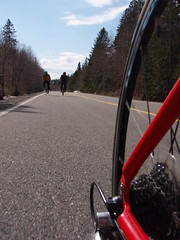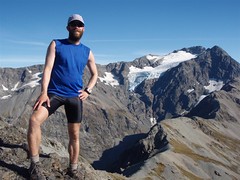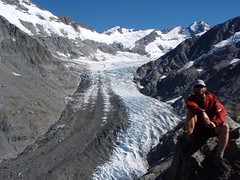Good news everybody. Today I can finally write about getting out of the safari vehicle and actually doing some real hiking. Mind you, I’m not talking about a multi-day challenging trudge or anything, but at least the dust in my nose would be from kicking at the dirt rather than by driving through it, so that’s something. Our first foray into the hills was a hike up Mount Lemagrut, which is one of 9 craters in the Ngorongoro conservation area. Although we’d be trekking up to 3100m this day, we were starting out at about 2400m, so the overall altitude gain and loss wasn’t going to be that great. This would however serve as our first acclimatization hike of sorts, and give us an idea how we might do as a group on the more challenging days ahead of us. This is also the first time I’ll be sharing a nice map of the trek with you all. As you might expect, I carried a GPS with me for most of the trip, and made a number of maps to show you where we went. Along with the map you can also head to flickr and check out the set of pictures and videos from the day. Once you’ve taken all that in and set the scene, come on back and read the rest of my tale!
Our day got off to a nice start, as the sun was shining, and there were almost no clouds in the sky. We all got back together for our final breakfast at the Rhino lodge, and before we knew it we were packed back into our safari vehicle for another dusty ride to the start of our mountain trail. The way to the trail was some more dirt roads winding its’ way around the park. We drove by several Masai villages just waking up for the day. Each night in these villages, the Masai take their animals in to protect them from predators, and each morning, the animals are led back outside the village to graze during the day. There are fairly well defined roles and responsibilities in the villages as well. The young boys are first allowed to tend to the goats and sheep, and as they get older, they are eventually given the responsibility of looking after the cows, which are a sacred animal to the Masai.
At any rate, it was always an impressive site to see the Masai around their villages. They typically wear just a red coloured cloak and have leather sandals. To protect the animals, each warrior carries a long slender spear, and a knife strapped to their waist. Nothing more. To become warriors, they must prove that they are capable of killing a lion with their bare hands. Of course, they aren’t actually allowed to kill lions anymore, but that is the way tradition was. Furthermore, they must wander the plains usually for around a year before they are ready to become true warriors. It makes for a very fascinating way of life (at least to us tourists). The Masai have lived this way for hundreds of years, and will likely continue to live that way for hundreds more. That isn’t to say that many young people are lured away to the ‘cities’, but the culture does indeed appear to still be alive and well.
Before getting to the mountain, we also had to swing by the ranger station to pick up our ‘guide’, which is basically an armed ranger to hike with us. His job? Lead us up the mountain, and make sure no animals decide we’d make a nice snack. To fulfil that part of his job, the ranger carried, what else, but an automatic weapon. Apparently we had to wake him up to get him to join, but after seeing his gun, we decided not to give him too hard a time 🙂 His english was spotty at best, but he did try his best throughout the day.
Along the walk, I learned that he himself was also a Masai warrior. I saw my opening, and asked him why he wasn’t defending us with only a spear and a knife. His response? With a pretty much straight face he showed me his weapon, and said “automatic spear”. ‘Nuff said. I cracked up with that one. It was easily the quote of the entire trip to me! 🙂
Upon arrival at the start of the hike, our little team was quite excited to actually get on our feet I think. We stood around the truck while our driver Julius explained that the guide would take us up alone, and that he would be back at 3:30pm to pick us up. And with that, we started our hike. The path first took us through another couple villages, where we got a closer glimpse of life in the villages. There were lots of children interested in talking to us and seeing what we were up to. The guide always seemed to take the time to talk to the children and learn a bit about them. He was also quick to keep reminding us that taking pictures of the villagers was a definite no-no. We could take some pictures of the village provided there were no people in the shot, but that was about it. If we really wanted a picture though, it would have simply been a matter of paying some money to the village. We weren’t too keen on that though, so we kept our cameras respectfully out of sight for the most part.
The actual hike was really pretty easy. Think of it as a gradual hike up grassy slopes. The terrain changed a few times, but in general, there wasn’t much to this hike. A couple of us were keen on hiking a bit quicker that others, but for safety reasons, we all had to maintain pretty much the same pace. This sort of modus operandi would repeat itself throughout the rest of the trip. In this case, it was mainly to make sure no animals were stalking any of us or would take us by surprise. I’m happy to report that fear never materialized. The most we saw were a few buffalo. No lions or anything else of real danger.
Our biggest struggle probably would have came when we had to hike through the really high grass, that tended to grow in ‘clumps’. At the top, is just looks like a field of deep grass, but you soon found out that at its’ base, all of the grass was part of clumps, meaning we kept tripping or bumping into the clumps. It wasn’t very graceful. However, we got through it unscathed.
About halfway up, we stopped at a nice spot to have a look down the valley to the villages. It was a nice moment. We hadn’t really been working too hard, but it was still nice to finally be ‘away from it all’. Here we were, high up on a grassy slope, no cars, no roads, no people, no noises. Just us. Looking down in the sunshiny day at African tribal villages. In the distance we could see other lakes in the region, as well as the general national park goodness that was all around us. We snapped a few shots, including a group shot, then turned tail and started making our way up to our eventual lunch stop at that 3,100m mark of the mountain. We got there in what was probably exactly the time that the guide had anticipated. Here’s another funny thing about the Masai. We were told they usually only drink once a day, and rarely need food or water. However, before too long on the hike, our guide actually asked for water from Deb. A bit ironic I thought, but we decided not to poke fun, nor tell the elders. Wouldn’t want him to get in trouble would we? We also gave him food while we ate lunch at the top, as he didn’t have anything with him.
The view from the top? Well, let’s just say it was very peaceful. We each ate our boxed lunch and then laid back and relaxed and watched the world roll by at our feet. We had a view down to the Serengeti, although much like the crater, from our height, we couldn’t see much other than vast land stretching before us. We were actually able to roughly trace out the route we’d driven yesterday, as we could make out the ribbon of road, and picked out the Olduvai Gorge, then on to the actual Serengeti where we drove around far off in the distance. I felt completely relaxed for the first time in quite a while. Having nothing in particular to do or place to be, I just let myself watch the clouds and shoot the breeze with my travel mates.
However, I eventually became a bit antsy, and got my pack back on and asked if it was time to go. Turns out, it was 🙂 We loaded back up and once again picked our way back down the mountain. Funny enough, I kept getting the feeling that the guide didn’t really have a route in mind, he just meandered throughout the various trails and fields, trying to avoid the grasses that would irritate our legs (and there were quite a few of those). Wearing shorts would have been ill-advised. Even through pants, most of us ended up getting some irritations. Generally, it would last for about 15-20 minutes of burning, then pass. Not fun, but not the end of the world.
The route down was another leisurely stroll for the group. It was obvious that not everyone wanted to go at the same pace when we were hiking, but all in all, I didn’t see any need to get concerned about pacing or our ability to finish the hikes. It was a great first day of hiking. We made it out to meet Julius right on time, and made our way to a permanent camp at a place called Lake Manyara for the evening. I’ll write a bit about that in another post, but basically, we were going to have a day more or less off to do some shopping and touring before preparing for our major hikes. Check back later for those stories.
Thought of the day for this post? Life is as hectic and as complicated as you make it to yourself. Keep that in mind, and you can slow it down when you need it to. Take the time to just look at the clouds sometimes. It’ll help clear your mind and get ready for what’s next 🙂






